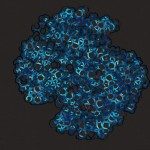Lien vers Pubmed [PMID] – 19217388
Structure 2009 Feb;17(2):172-82
The signal transduction ATPases with numerous domains (STAND) represent a newly recognized class of widespread, sophisticated ATPases that are related to the AAA+ proteins and that function as signaling hubs. These proteins control diverse biological processes in bacteria and eukaryotes, including gene expression, apoptosis, and innate immunity responses. They function as tightly regulated switches, with the off and on positions corresponding to a long-lived monomeric, ADP-bound form and a multimeric, ATP-bound form, respectively. Inducer binding to the sensor domain activates the protein by promoting ADP for ATP exchange, probably through removal of an intramolecular inhibitory interaction, whereas ATP hydrolysis turns off the protein. One key component of the switch is a three-domain module carrying the ATPase activity (nucleotide-binding oligomerization domain [NOD]). Analysis of the atomic structures of four crystallized nucleotide-bound NOD modules provides an unprecedented insight into the NOD conformational changes underlying the activation process.


